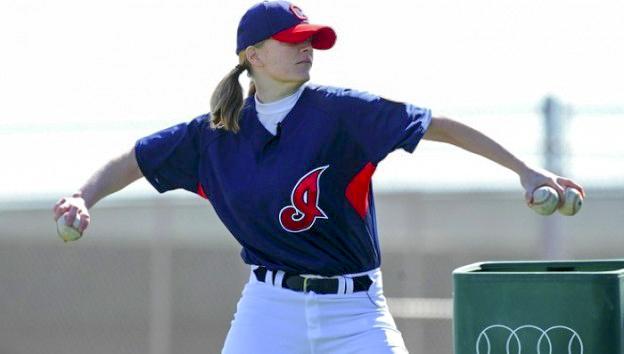In The Locker Room with Justine Siegal
Justine Siegal makes history pitching at Cleveland’s batting practice.
December 2, 2016
Justine Siegal is the first woman to coach and throw batting practice in Major League Baseball. She earned her first coaching job in 2015 with the Oakland Athletics. In 2011, Siegal first threw batting practice to Cleveland, later working with the Tampa Bay Rays, St. Louis Cardinals, Houston Astros and New York Mets. Most recently, Siegal founded a nonprofit organization, Baseball for All, which provides opportunities for girls to play baseball and educates the public on gender equity in sports.
This interview has been edited for length and clarity.
Q: Growing up, did you always want to coach in the MLB?
I grew up as a girl who always wanted to play sports. Then, you would call me a tomboy. Now, it’s pretty normal for girls to play sports. I knew I wanted to become a coach when I was 16. Quite frankly, I wanted to first play for [Cleveland]. When I realized I wasn’t going to play for them, then I thought, “Well, maybe I could become a coach.” And I started working since I was 16 on how to get there.
Q: How did your educational background help you achieve your dreams in coaching?
I decided to get a Ph.D. [in Sport and Exercise Psychology], when I was 16 actually, because the first person I told that I wanted to be a college baseball coach laughed at me. I thought, “Well, I won’t have the same opportunities as men to play professionally, but at least I can out-educate most of them.” It has allowed me to break boxes, and it’s often a lead-in when I’m applying for a job or in the media. It legitimizes some of my knowledge, and when you’re coaching with professionals you’re bringing a different tool to the toolbox, which is really important.
Q: What have the naysayers said to you, and how do you ignore them?
When I was a teenager, I had a lot of things said to me. Whether it’s sexual taunts or whether it’s telling me that it’s against God’s way to play baseball. But the younger generation is much more open, and I haven’t really been having any troubles other than just continually trying to get opportunities. The men that I work with, who are 20–23, like having a female coach. Once you can show that you know what you’re doing and you can help them, they don’t care. They think it’s cool.
Q: Being the first woman to throw batting practice to a MLB team, what was that experience like?
Throwing batting practice when you’re me is like show time because unless you’re with the team regularly, everyone wants to see if you can do it. So everyone stops to watch and then it circulates around. I always get really nervous unless you’re with the team for a while, then it’s just batting practice. It’s fun to be in this joint action together. You’re throwing and they’re hitting. There is a flow to it and you’re helping them get their rhythm, but you are part of the rhythm. It’s like that athlete feel of why you play.
Q: What did receiving your first coaching job with the Oakland Athletics mean to you?
I worked for the A’s for two weeks during instructional camp. It seems like two weeks is nothing, but it took me four years of asking to get that opportunity. It really was a breakthrough moment for professional baseball and for me. Of course, it feels amazing. I got to put an A’s uniform on and go coach baseball. … I understand the significance of being the first, but that’s not why I did it. I did it because I love baseball and I love to help players.
Q: Did you enjoy your experience working as the mental skills coach with Team Israel and what did you learn from international players?
I spent about 10 days with the team, so you have to quickly gain the trust of the players. The other coaches already have their trust because they have already been established as managers in professional baseball. We definitely felt like a team when we won. It was just really special to wear Israel across my chest and to think of my grandfather. It’s another dimension, and it was really cool.
Q: What are the goals of your self-founded nonprofit organization, Baseball for All?
I founded Baseball for All for girls to get to play baseball with other girls. When I was a kid I felt really alone being the only girl and I thought to myself, “What would I have liked? To play baseball with other girls.” That’s what we do. We are the leaders and we are really changing the general landscape of getting more girls involved in baseball. We want them to know they can do it.
Q: Are you satisfied with the direction of female inclusion within the MLB?
The MLB started a diversity initiative to get more women involved. I think that more needs to be done. First, we have to get girls playing baseball. I know that there are also women with softball backgrounds that have done really well at different jobs. I’d like to see more. We are really just starting.
Interview by Darren Zaslau, Sports editor
















